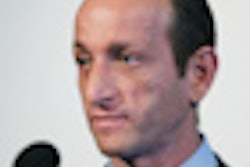
VIENNA - Airport security scanners are safe for individuals, but when their effects are considered collectively, there is still a risk of cancer developing due to the machines, ECR 2013 delegates learned at a standing-room-only session on Thursday afternoon.
It's been two years since backscatter scanners -- often called "naked" scanners in the popular press -- were installed at many airports, but interest in the machines is still quite high, as evidenced by the number of attendees at the ECR session. There are two kinds of security scanners: backscatter scanners that use x-rays (ionizing radiation) and microwave scanners.
Backscatter security scanners backscatter photons. The equipment consists of two x-ray tubes, collimators, and detectors on both sides of the exposed passenger. Radiation detectors detect photons scattered back from the body and the scanner builds up front and back images of the individual.
 Dr. Peter Vock.
Dr. Peter Vock.
Microwave scanners employ radio waves at millimeter wavelengths which penetrate clothing and have short enough wavelengths to reveal small, concealed objects.
The effective radiation dose to travelers from a backscatter x-ray scan is approximately 0.05 µSv to 0.1 µSv, which is the equivalent of less than two minutes of flying in an aircraft at cruising altitude, according to Dr. Peter Vock, professor emeritus of radiology and former chairman of the Institute of Diagnostic, Interventional, and Pediatric Radiology at Inselspital in Bern, Switzerland.
One hour of air travel is equal to about 40 to 80 backscatter scans; a chest radiograph is 1,000 to 2,000 scans, and a CT scan is 50,000 to 100,000 backscatter scans, he added. However, considering the number of security scans per year -- approximately 1 billion in the U.S. alone -- there is the possibility that 15 people will develop cancer due to the backscatter scans, according to one of the other presenters, John Damilakis, PhD, from the department of medical physics at the University of Crete in Greece.
There is also the question of how backscatter x-rays affect children and infants, who are much more susceptible to radiation, as well as how different organs are affected, Damilakis added.
If the "as low as reasonably achievable" principle is employed -- meaning radiation should be avoided or the amount kept as low as possible -- it's important to weigh the risks and benefits of backscatter scanners.
"With the low-energy x-rays used in backscatter scanners, the results are good for excluding foreign bodies, such as weapons, on the body surface," Vock said. "The method is less effective for detecting objects in deep body cavities and might occasionally even miss superficial objects."
Considering that backscatter scanners don't detect everything, but they do carry a small risk of cancer from repeated exposure, the European Union recently banned them.
The Transportation Security Administration (TSA) in the U.S. has also started to remove backscatter scanners from the major airports, and by June all of them should be gone, according to the TSA.
This should come as a relief to air travelers who have been concerned about privacy. The scanners can create detailed images of the skin surface and have been accused of producing overly revealing images of the body.



















